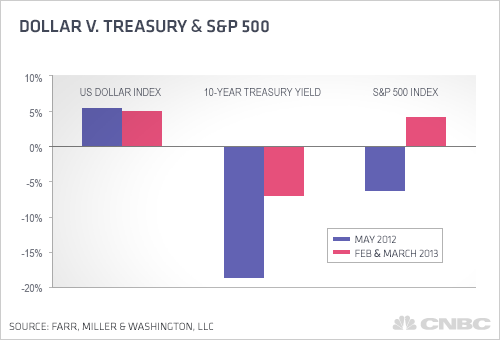(Read More: Play the Cyprus Crisis, Buy This Currency: Pro)
The last time we saw a dollar strengthening of this magnitude was during in May, 2012. That month, too, was characterized by renewed fears about problems in Europe. There was widespread speculation that Greece might leave the European monetary union. Some also thought that a Greek exit would trigger a contagion, leading to other departures and the ultimate dissolution of the monetary union.
In our March 23, 2012 Market Commentary, we wrote the following:
Markets around the world continue to be volatile in response to concerns about the situation in Europe. As the value of "risky" assets has been falling in recent weeks, money continues to pour into the safety of the US dollar and US Treasuries. The US Dollar Index (ticker symbol DXY), which is a measure of the value of the dollar against a basket of six major currencies, is trading near a 20-month high. The yield on the 10-year Treasury note, which moves in the opposite direction as the bond's price, is now close to a record low at 1.74%. Investors continue to display an insatiable appetite for an asset that will not yield enough to cover the expected rate of inflation, resulting in a loss of purchasing power. While this type of irrational investor behavior cannot go on forever, it does signal that investors are protecting against some very nasty tail risks. This European problem just won't go away.
While the recent flair-up involving Cyprus may not be as threatening as the Greek drama experienced last year in May, it also seems that investors have become somewhat desensitized to the issues across the pond.
Prior to this year, sharp increases in the dollar index (reflecting European fears) were generally accompanied by a sharp rally in U.S. Treasuries and the indiscriminant selling of stocks. This knee-jerk reaction to exogenous shocks came to be known as the "risk-off" trade because any security containing risk was shed in favor of those offering principal security.
(Read More: Is the Dollar Dying? Why US Currency Is in Danger)
This time around, however, investors don't seem to be so alarmed. While the dollar has appreciated by a similar magnitude as last May,Treasury yields have fallen less than half as much, and stocks have actually appreciated in value.
The chart below graphically displays the differing market reaction to the crises. From this chart, we can draw one of two conclusions: 1) either (and quite possibly) the European situation is not the threat it once was, or 2) investors have become much more risk-tolerant.




